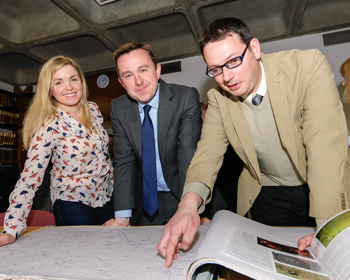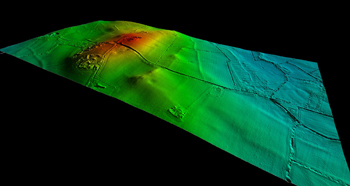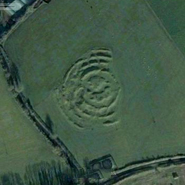Posted 22 April 2014
UCD archaeologists begin excavations at Meath site linked to Druid festival of Samhain
With funding from the Office of Public Works, Meath County Council, the Heritage Council and the Royal Irish Academy, a team of six professional archaeologists and about 20 volunteers will begin excavations at the hilltop enclosure of Tlachtga at the Hill of Ward, near Athboy in County Meath in May.
Mr. Brian Hayes TD, Minister of State with responsibility for the Office of Public Works officially announced the funding during a visit to the School of Archaeology at University College Dublin where he reviewed plans for the excavation of the site.

Pictured: Minister Brian Hayes views plans of the Hill of Ward excavation site while on a visit to University College Dublin. Dr Stephen Davis (right), UCD School of Archaeology, who will lead the excavation and Ms Cathríona Moore (left), UCD graduate, who will collaborate on the project.
"I am delighted that my Office is associated with these studies which will greatly inform the understanding of this historic site,” said Minister Hayes. “I have no doubt the project, led by Dr Stephen Davis, will provide the volunteers and professionals alike an exciting opportunity to work on such an important excavation.”
It is understood that the land where the site is located is privately owned and that the owner is in full support of the works going ahead. The site is about 12 miles from the Hill of Tara and medieval texts link it to the Druidic festival of Samhain.
Samhain which was celebrated from sunset on 31st October to sunset on 1st November marked the end of the harvest season and the start of winter. It is believed that torches were lit from the sacred fire on the site on the Hill of Ward and then carried to several other hills around the county including the Hill of Tara.
“We have already investigated the site using airborne laser survey and geophysical techniques but no excavation has taken place so far,” says Dr Stephen Davis from the UCD School of Archaeology, University College Dublin who will lead the excavations in collaboration with UCD archaeology graduate, Ms Catríona Moore.

“These surveys clearly reveal that the site has several different phases of monumental enclosures and we believe them to be associated with festivals and rituals potentially dating back as far as 1,000BC.”
“There are at least two forts on the site – one measuring 150 metres in diameter which was partly built on top of another, ever larger, fort measuring almost 200 metres wide,” he says. “Given the size, this was almost certainly a key ritual site for many generations. But we will only be able to tell for sure after we complete the excavations.”
About Samhain
According to Irish mythology, Samhain (believed to be the ancient Celtic origins of Halloween) was a time when the doorways to the Otherworld opened and journeys could be made from one side to the other. It was also a time when animals would be chosen for slaughter for the winter months, and this would be followed by feasting. Druids (Celtic priests) who are believed to have practised religious rituals on Samhain are thought to have predicted the future by reading the entrails and movements of the animals slaughtered.
(Produced by UCD University Relations)

